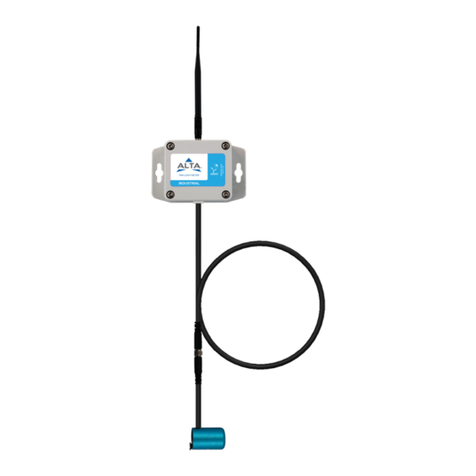I. ABOUT THE WIRELESSS 150 AMP AC CURRENT METER
The ALTA wireless AC Current Meter measures the RMS current of an alternating current
(AC) system using a current transformer (CT) that wraps around the “hot” wire of a two wire
(hot, common, ground(optional)) power system. The sensor reports Minimum RMS current,
maximum RMS current, average RMS current, and amp hours to the iMonnit system. The
iMonnit system is capable of generating watt hour or kilowatt hour readings as well.
PAGE 1
ALTA WIRELESS 150 AMP AC CURRENT METER FEATURES
• Wireless range of 1,200+ feet through 12+ walls *
• Frequency-Hopping Spread Spectrum (FHSS)
• Interference immunity
• Power management for longer battery life **(12+ years on AA batteries)
• Encrypt-RF® Security (Die-Hellman Key Exchange + AES-128 CBC for sensor
data messages)
• Onboard data memory stores up to hundreds of readings per sensor:
- 10-minute heartbeats = 3.5 days
- 2-hour heartbeats = 42 days
• Over-the-air updates (future proof)
• Free iMonnit basic online wireless sensor monitoring and notication system to
congure sensors, view data and set alerts via SMS text and email
* Actual range may vary depending on environment.
** Battery life is determined by sensor reporting frequency and other variables. Other power options are also
available.
EXAMPLE APPLICATIONS
• Current Monitoring
• Current Usage
• Amperage Monitoring
• Amp Hour Meter
• Measures amp hours, max RMS current, min RMS current, and average RMS current
• Two dierent current transducers available:
• Low Current: 0-20 amp
• High Current: 0-150 amp
• Capable of generating watt hour or kilowatt hour readings using iMonnit
• Data logging for accumulated amp hour readings
• Can notify based on current levels or changes in current levels
• Simple and safe installation of current/power
measurement hardware, no rewiring required
To measure current, clip the CT around only a single wire of the AC system (clipping around
a hot and neutral wire at the same time will result in 0 current readings). After the sensor
powers on and connects to the gateway it will begin taking measurements based on the
averaging interval (5 seconds default). It will report data to iMonnit every heartbeat or if the
current goes outside of the aware thresholds set in iMonnit. The sensor reports amp hours,
max RMS current, min RMS current, and average RMS current. iMonnit can also generate
watt hour or kilowatt hour readings if a default RMS voltage is set in iMonnit.




























